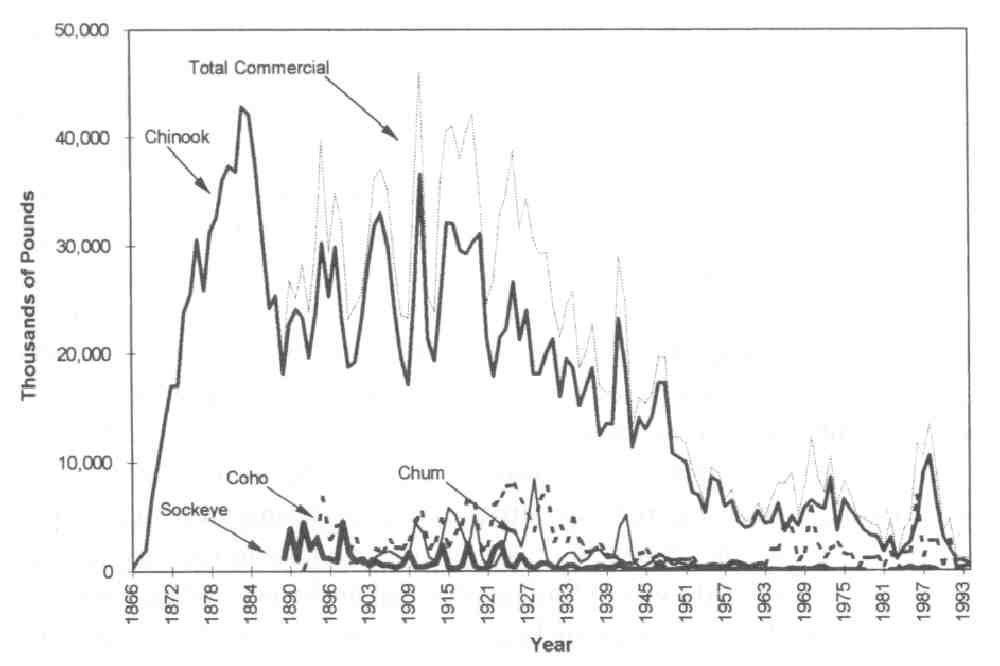
Figure 1. Catch data showing chinook, coho, chum, and sockeye salmon taken from the Columbia River, 1886-1994. Source: (Lichatowich, 1999)
Between 1976 and 1979, coho salmon populations crashed and in some rivers went extinct (Lichatowich, 1999). Hatcheries have been successful only in supplying the fishing industry with a product. Salmon expert, Edgar Birch said, "We should have listened to people who were telling us that hatcheries were a bad idea. . . . from the very beginning." (Lichatowich, 1999).
Harvest is another part of the problem. When correctly interpreted, catch data from fishermen is often used to gage the health of certain stocks. To illustrate, the Columbia River produced 43 million pounds of fish in 1883. By 1940, this had dropped to 16 million pounds. A federal committee was formed to investigate the cause. They concluded in 1943 that the main factor involved was over harvest. By their own estimates, 90 percent of summer-run chinook on the Columbia were taken by the fishing industry (Lichatowich, 1999).
Hydropower is the fourth problem. The Elwah River is 45 miles long and has more than 100 miles of tributary streams. A dam built in 1913, completely cut off a unique run of chinook along with nine other runs. The upriver forests and animals are no longer fed by the salmon. The Columbia River is another classic example of dams which have blocked more than 75 percent of salmon habitat (Rapp, 1997).
Educating people on these four issues is one way to solve the salmon problem. Teach them how river dynamics play a role in salmon habitat. Dams interfere with this sort of equilibrium that rivers try to maintain. Show them the importance of pristine, undeveloped riparian zones. These areas serve as cool, nutrient filled nurseries for juvenile salmon. Encourage people to support aggressive and strategic legislation. Reason with people that laws and regulations can help salmon numbers rebound. In the past, laws to protect salmon were conflicting or under funded. Too often, monies were not available for enforcement. In 1887, only three wardens were expected to enforce a closed season on 200 miles of river (Lichatowich, 1999). A committee was formed in 1937 to restore salmon to the Fraser River. Using only $21 million, they were able to increase sockeye numbers from 3 million in 1949, to 22 million in 1990. Another similar committee spent a staggering $3 billion to do the same on the Columbia and failed to achieve the same results. Legislation needs to produce goals that are both well researched and well funded. The committee on the Fraser project understood the need for habitat restoration because they researched the problem. The Columbia project was generously funded, but the committee forgot to look at habitat degradation and hydropower as key to solving their problem (Lichatowich, 1999).
Economics also plays a role to salmon recovery. It must be understood that many stand to lose money or jobs if dams are breached or if fishing is heavily restricted. For example, jobs have to be available to those who are affected by mill closures. The federal government has the ways and means to assist communities impacted. Personal losses can sour the public on issues meant to benefit them in the long run. I feel incentives or compensation must be offered to help minimize these losses. Tax breaks ought to be extended to commercial fishermen who taper off their harvests. Likewise, taxes ought to be levied on salmon exported and these taxes turned into funds to restore salmon habitat.
When examined, the solution seems obvious. Perhaps we are looking at this as an environmental problem when it is simply, a psychological one. Humans are creatures of habit and tend to resist change. To illustrate, people used to feel smoking was not harmful. Our government then spent billions of dollars and decades to show it caused cancer and a host of other illnesses. Several media campaigns by private and federal organizations led to a greater awareness of smoking dangers and has resulted in fewer smokers today. It was expensive, but the false notion that smoking did no harm, was reversed. Resource exploitation also arose from false conceptions that our earth can provide an endless supply of whatever was needed. This ideal led to hundreds of years of a unique mind-set. Europeans of the 14th and 15th centuries came to fear the deep forest. Myths and tales told of danger and evil lurking in forests. Therefore, settlers were encouraged to clear the land of the forest "primeval" and tame the land (Shew, 1999). Fishing was unrestricted on the high seas, which had "open access" to any who sailed them. These concepts and ideals led to "The tragedy of the commons." The tragedy of this situation is that it best rewards those who most heavily exploit and abuse the unprotected resource (Sumich, 1999). This common mode of exploitation was repeated wherever settlers went. Humans have systematically treated all available resources with contempt and disregard.
As for salmon, they now need for us to make some radical changes or they will not survive. An unprecedented public education campaign must be launched. This will inform people of the stakes if we lose salmon and encourage them to change their ethical view of the environment. All the best ideas, all the money in the world, and the best speeches mean nothing if the hearts of the people are not reached.
Works Cited
Lichatowich, J. (1999). Salmon without rivers. Washington, D.C.: Island Press.
Rapp, V. (1997). What the river reveals. Seattle, WA.: The Mountaineers.
Shew, D. (1999 , August 18). [Lecture on Tragedy of the Commons]. Unpublished raw data.
Sumich, J.L. (1999). An introduction to the biology of marine life. (7th ed.). New York: McGraw-Hill.